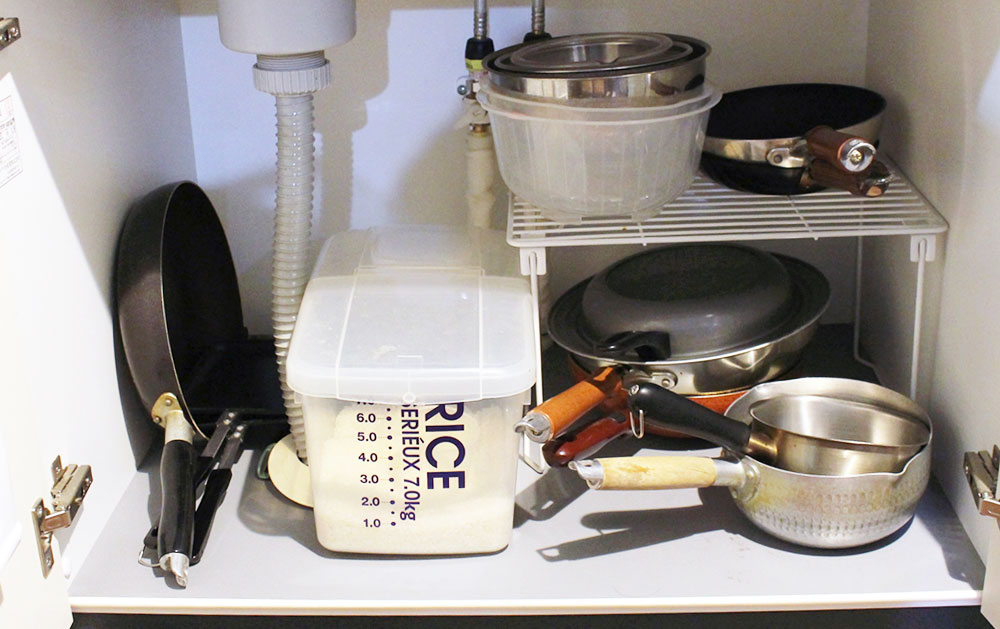Don’t store rice in bag at room temperature! A farmer teach how to store rice

I just bought some rice and left it in the bag, but I don’t know if this is the right way… I need to know how to store it right!

Rice is actually a perishable food. If stored incorrectly, it can lose its flavor, or worse, become infested with insects and mold!
Farmers put a lot of time and effort into growing delicious rice. Why don’t you review how to store rice so that you can enjoy its taste?
This article is about
- Can I store rice at room temperature?
- Why can’t I store it under the sink?
- Where should I store it?
- How long can I store it?
- What storage containers do you recommend?
- How to keep rice tasty for a long time
These are the important factors in the storage of rice
- Storage location
- Storage period
- Storage container

Store it right, and you’ll have great-tasting rice!
Don’t store rice at room temperature or under the sink

Some people may store rice at room temperature or under the sink, but this is not a suitable storage location for rice.
In humid environments such as summer or during the rainy season, rice absorbs moisture and oxidizes, resulting in a loss of flavor and, worst of all, mold. In Japan, rice is sold in plastic bags, but the bags have small air holes that absorb moisture even if the bags are unopened. Especially under the sink is a definite no-no because of the high humidity.
And in the summer, temperatures are also high. Storing rice in a place where the room temperature is above 15°C (59°F) increases the possibility of insect infestation.

In summer, it would be better not to store them at room temperature. But in winter, temperature, and humidity are lower, so room temperature is fine.

That’s not really the case.
The air becomes drier during fall and winter. If rice is left unsealed in a dry environment, the surface will crack or the rice will break. Cooking such rice will result in soggy rice.
Suitable Places to Store Rice
The following locations are suitable for storing rice
- Temperature is low (around 5°C/41°F)
- Humidity is neither too high nor too low (around 70%)
- Not exposed to direct sunlight
- A dark place
So, where is the best place?

The best place to store rice is in the vegetable compartment of the refrigerator. The reason is that it is a cool, dark place with a low temperature.
The ideal temperature for long-term quality preservation
It can be stored at a constant temperature regardless of the season, and of course, it can be kept dark and out of direct sunlight. Generally, the temperature in the vegetable compartment is 3°C (37.4 °F) to 8°C (46.4 °F), depending on the manufacturer, which is the ideal temperature for long-term quality preservation.
Some people say the ideal storage temperature for rice is said to be around 15°C (59°F). This is the ideal temperature for rice makers to store brown rice in terms of both running costs and quality preservation. Storing rice at a low temperature puts it in a state of hibernation and slows down the rate of oxidation, so if quality preservation is the first priority, a temperature of around 5°C (41 °F) is ideal.
There is a variation with regard to humidity
The humidity level in the vegetable compartment varies from manufacturer to manufacturer and model to model. Generally, the humidity is 20% to 50%, 60% to 90% for those with a high humidity function, and some do not even adjust the humidity. Although 100% humidity may not be ideal, the vegetable room is still a reasonable storage location for the average household.
Shelf life of rice
Rice is treated as a perishable food and has no expiration date or consumption date listed. Therefore, when purchasing rice, please pay attention to the date of milling.
Rice deteriorates as each day passes after milling, so the fresher the rice is when the milling date is newer.
To enjoy the best taste, eat the rice as soon as possible after purchase (after milling). As mentioned earlier, there are small air holes in the rice bag, so it does not matter if the bag has not been opened.
Approximate length of time for good storage
- Autumn and winter (October to February): 2 months
- Spring (March to May): 1 month
- Summer (May-July): 3 weeks
- Midsummer (July to September): 2 weeks
After the above period, the flavor will be less, but not inedible. It is up to the consumer to judge for themselves, but as long as there are no insects or molds and the appearance is not visually unsightly, they can be eaten.
Rice Storage Containers
Not in a plastic rice bag. Refill into the right container
Rice oxidizes and loses its flavor when exposed to air. It also absorbs odors easily, and once an odor is attached, it cannot be removed.
Therefore, it is important to seal the rice tightly when storing it. Rice bags have small air holes in them, so instead of storing the rice as you bought it, transfer it to a sealed container.
Keep containers clean
When rice is used up, wash it clean and refill it with new rice. Old rice bran and debris left in the container may cause insect infestation.
Recommended Storage Containers
Here are recommended storage containers and the advantages and disadvantages of each.
PET bottle (clear plastic beverage bottle)
Reusing plastic bottles is inexpensive and eco-friendly.
Rice tends to smell easy, so use a plastic bottle that used to contain mineral water. If you use a PET bottle that has contained juice or tea, wash it well and dry it before use.
Advantages
- inexpensive
- Easy to take out rice
- Can be stored vertically or horizontally
- Eco-friendly
Disadvantages
- Narrow mouth, so it takes a lot of time to put rice in
- Difficult to wash
- It takes time for the inside to dry after washing
The narrow mouth makes it troublesome to use a ladle or other tool to put rice in. It is also difficult to wash and takes time to dry completely after washing. If rice is put in before it is completely dry, it can cause mold.
Asvel Rice Stocker 4.4 lbs (2 kg)
Advantages
- Comes with a measuring cup
- The sealed structure allows for both vertical and horizontal storage
- Easy to clean
Disadvantages
- Only holds 2 kg (4,4 lbs) of rice
If you buy more than 5 kg (11 lbs) of rice, you should buy several bottles.
Ziploc
<
Advantages
- Can be sealed
- Easy to load and unload rice
- Inexpensive
- Compact storage
- No maintenance required
Size XL can hold about 5 kg (11 lbs) of rice. It can be sealed, and easy to put rice in and out. Also, it can be compacted as the amount of rice is reduced. The price is about 350 yen for a pack of 5 XL size bags, which is 70 yen per bag.
Disadvantages
- Increased waste
Disposable bags are not eco-friendly since the current trend in the world is to reduce plastic waste. Although they can be washed and used repeatedly, the bags take quite a long time to wash and dry completely, which increases the time and effort required.

Choose the product that best fits your lifestyle based on the advantages and disadvantages of each!
Summary
Store rice in an airtight container in the vegetable compartment.
After milling, the rice should be eaten within 2 months in fall and winter, 1 month in spring, and 2~3 weeks in summer.
Recommendations for rice storage containers
Plastic bottle
Asvel Rice Stocker 4.4 lbs (2 kg)
Ziploc

By all means, store it right, and have some good rice!
 コメント
コメント
 ホーム
ホーム 2023年2月12日
2023年2月12日

